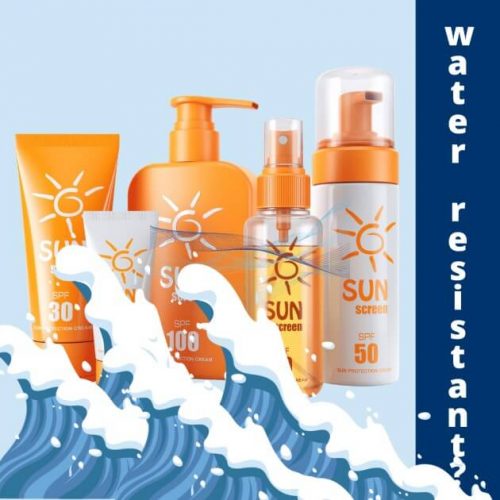Increasingly, I am seeing Made in India sunscreens have an 80 minute water resistance claim. The following image is from Brillare’s mineral sunscreen:

The first time I saw such a label was in the US, where “40 minute water resistance” and “80 minute water resistance” claims are common, because they have more sunscreens designed for sport.
BUT what does it mean? Given that there is no global standard on sunscreen regulation, it really does depend on the country in which the sunscreen is manufactured
Made in the EU sunscreens
We are fortuitous that the EU revisited labelling back in 2006 (so just a decade and a half ago). Haha – its a sunscreen joke for you.
Anyway, the EU looked at labelling on sunscreens, and said that
“Claims concerning the efficacy of sunscreen products should be simple, meaningful and based on identical criteria in order to help the consumer to compare products and to choose the right product for a given exposure and skin type.”
I find this really useful because in relation to WATER, this is what is straight from the horses mouth (i.e., the relevant EU rules):
Sunscreen products should carry instructions for use, including: ‘Re-apply frequently to maintain protection, especially after perspiring, swimming or towelling’.
No claim should be made that implies:
(a) 100% protection from UV radiation (such as ‘sunblock’, ‘sunblocker’ or ‘total protection’);
(b) no need to re-apply the product under any circumstances (such as ‘all day prevention’).
What exactly does the EU say on “water resistance”???!
Nothing.
The EU tells which are permitted label claims and by default which are not.
Making water resistant claims in the EU is not permitted by the regulator.
Source: Commission Recommendation (2006/647/EEC)
Made in the USA sunscreens
India and the EU regard sunscreen as cosmetics, but in the USA, sunscreens are regulated as OTC drugs. The structure of American regulation on water related claims is quite haphazard.
In 2011, the following claims on sunscreens were no longer permitted:
(i) Claims such as “sunblock,” “sweatproof,” and “waterproof”
(ii) Claims for “all-day” protection, or extended wear claims citing a specific number of hours of protection that is inconsistent with the directions for application
Source: Enforcement Policy on OTC sunscreen drug products marketed without an approved application guidance for industry, a US FDA document
Are water resistance claims permitted in the USA?
Yes, but only if the OTC sunscreen passes a particular test to claim water resistance (40 minutes) or water resistance (80 minutes).
These are instructions for measuring water resistance:
(i) Water resistance (40 minutes). Determine the SPF value after 40 minutes of water immersion using the following procedure:
(A) Step 1: Apply the sunscreen test product as prescribed
(B) Step 2: Perform moderate activity in water for 20 minutes.
(C) Step 3: Rest out of water for 15 minutes. Do not towel test site(s).
(D) Step 4: Perform moderate activity in water for 20 minutes.
(E) Step 5: Allow test sites to dry completely without toweling.
(F) Step 6: Apply the SPF standard as described
(G) Step 7: Expose test sites to UV doses as described
This is quite a specific test but importantly, you cannot towel dry yourself! We are not here to discuss the adequacy or inadequacy of such a test – what I want you to take away is this: there is a test for 40 minute or 80 minute water resistance AND this enables me to compare American sunscreens with each other.
Made in India sunscreens
For India, sunscreen is not part of the public health policy agenda to reduce the incidence of skin cancer and therefore, there is no specific sunscreen regulation.
So while, manufacturers must (essentially) truthful claims on their labels, they decide what these claims are and not the regulator (which is non-existent!)
Therefore, when Brillare make “80 minute water resistance” claims on their sunscreen it is impossible for me to compare this to another sunscreen (e.g.) Lotus Herbals that may claim “80 minute water resistance.”
And this is a big problem for me….
Notice how specific the US test for water resistance is – it even specifies that no towel drying is permitted and the level of activity (moderate).
How are Brillare deciding what this test is, given that (e.g.) swimming and other water sports are not common in India? Are they referring to an actual sporting activity or just the local train ride in Mumbai to decide what water resistance is?
Who knows. But the important takeaway is that under Indian regulation, it is completely OK for another brand to construct another water resistance test and not tell the consumer.
Therefore, always, ignore such confusing and uninformative labelling.
